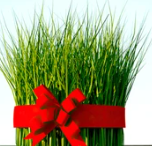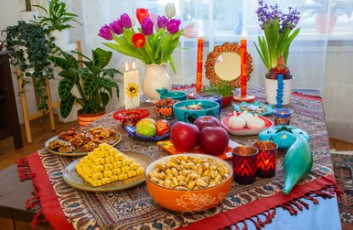What's Nowruz, the Persian New Year?
The most significant celebration of the year in Iran is Nowruz, which means "new day" in Persian. It has been seen for at least 3,000 years and is also celebrated in many countries. Interesting customs and traditions are performed on Nowruz, which are mentioned here.
What's Nowruz, The Persian New Year?
 The most significant celebration of the year in Iran is Nowruz, which means "new day" in Persian. It has been seen for at least 3,000 years and is also celebrated in many other countries in the Middle East, Central Asia, South Asia, the Balkans, and East Africa. During the decades that it has been honored, the celebration has evolved, and many countries have preserved or developed various traditions in addition to developing new ones.
The most significant celebration of the year in Iran is Nowruz, which means "new day" in Persian. It has been seen for at least 3,000 years and is also celebrated in many other countries in the Middle East, Central Asia, South Asia, the Balkans, and East Africa. During the decades that it has been honored, the celebration has evolved, and many countries have preserved or developed various traditions in addition to developing new ones.
Celebrating Nowruz involves:
- Reaffirming a life in harmony with nature.
- Being conscious of the interdependence of constructive effort and cyclical regeneration processes.
- Having a caring and respectful attitude toward the world's natural resources.

What Time Is It Celebrated?
The spring equinox, or Nowruz, occurs when day and night are of equal duration. Often, this happens on March 20 or 21. It's the day in the northern hemisphere when winter turns into spring, and it seems like a fresh beginning. Iran has four days of following public holidays and two weeks of school and university holidays.
Celebrating Nowruz is important in fostering relationships across nations based on respect for one another and the values of peace and good neighborliness. Its customs and traditions reflect Eastern and Western cultures and ancient traditions that affected those cultures via the exchange of human moralities.
How Do People Celebrate Nowruz?
Nowruz is welcomed by street performers known as Haji Firooz, who sing and play the tambourine while wearing colorful costumes.
By the use of shoe polish or a soot-and-fat concoction, the performers darken their features. Charcoal was frequently utilized in the past. They represent a fictitious character from Persian mythology.
The ceremony of Chaharshanbeh Soori is symbolic. The celebration begins with the lighting of the small fire in an open, free exterior space, which symbolizes a looking forward to a fresh beginning away from negative things. It takes place on the final Tuesday evening before Nowruz (March 17 this year).

For Nowruz, What Foods Are Served?
Families congregate at the house of their eldest relative on the first day of Nowruz.
Sabzi Polo Mahi (rice flavored with herbs and eaten with white fish), Ash Reshteh (a thick green soup with noodles, chickpeas, and beans), and Kuku Sabzi (vegetable frittata) are all part of the traditional New Year's meal.
Pastries include Baghlava, Toot (mulberry), Naan-Nokhodchi (pistachio and chickpea cookies), and Ajeel (dried berries and raisins).

What Is The 13 Be-Dar and How Does the Nowruz End?
Sizdah Be-dar, which translates as "getting rid of 13" (a bad luck sign) and "going to nature as people picnic outside," celebrates the end of the festivities 13 days after the New Year.
The focus of the two-week Nowruz celebrations is visiting with family, going on picnics, taking trips, and eating traditional food.
During Sizdah Be-dar, people picnic in parks, open fields, plains, and parks while bringing the carefully cultivated Sabzeh. They throw the Sabzeh into the nearby river or fields to represent returning to nature. The following day, businesses and schools often reopen.
The Philosophy of Haft-Sin, The Beloved Persian Tradition
It is relevant that many festivalgoers celebrate with seeds and eggs since the spring festival is focused on fertility and new life. Families arrange seven symbolic items, known as haft-sin, on tables.
- Sabzeh
For rebirth and regeneration, some form of sprout or grass will continue to develop in the weeks before the festival.
- Senjed
For love, a dried fruit, preferably a delicious fruit from a lotus tree.
- Sib
Apples promote both health and beauty.
- Garlic
It is a beneficial plant and treatment and taking care.
- Samanui
A delicious dessert for prosperity and wealth.
- Serkeh
Vinegar, for the endurance and experience that come with age.
- Sumac
A Persian spice used to celebrate the beginning of the new day prepared from crushed sour red berries. A haft-sin, literally translates to "seven S's," is built around these items.
Nowruz Is Mainly a Celebration of The Potential for New Life
The festivities of Nowruz are focused on community, family, and a profound regard for tradition, as is essential for Persian and Zoroastrian culture.
Yet Nowruz is more of a celebration of being able to start fresh by wiping away the grief, dirt, and dust of the past than it is about a specific day. It's about closing the book with one chapter and opening the new chapter with hope rather the disappointment. It's about the limitless options that a blank page offers.
The desire to begin something fresh and better is as global as they come, which may help to explain why Nowruz has not only survived but prospered through successive generations of turmoil and wealth.
To contact the Kalber dairy export department, refer to the contact section.
| https://www.vox.com/culture/2018/3/19/17138516/persian-new-year-nowruz-explained |
| https://learnenglish.britishcouncil.org/general-english/magazine-zone/nowruz |
| #nowruz #iranian_norouz #persiannewyear #nowruzcustoms #kalberdairy #foodindustry #dairymanufacturing |

-min(1).webp)
 (2).webp)
.webp)
.webp)